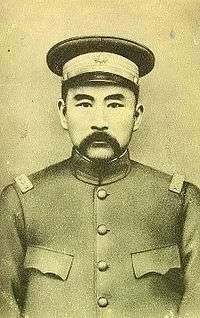Zhang Xun (Qing loyalist)
| Zhang Xun | |
|---|---|
 | |
| Prime Minister of the Imperial Cabinet | |
|
In office 1 July 1917 – 12 July 1917 | |
| Monarch | Puyi |
| Preceded by | Yuan Shikai (1912) |
| Succeeded by | Position abolished |
| Personal details | |
| Born | 16 September 1854 |
| Died | 11 September 1923 (aged 68) |
| Military service | |
| Allegiance |
|
| Service/branch | Beiyang Army |
| Years of service | 1884 – 1917 |
Zhang Xun (simplified Chinese: 张勋; traditional Chinese: 張勳,張勛; pinyin: Zhāng Xūn; September 16, 1854 – September 11, 1923) was a Qing-loyalist general who attempted to restore the abdicated emperor Puyi in the Manchu Restoration of 1917. He supported Yuan Shikai during his time as president.
Biography
Zhang served as a military escort for Empress Dowager Cixi during the Boxer Uprising. He later served as a subordinate of General Yuan Shikai in the Beiyang Army. He fought for the Qing at Nanjing in 1911, and then after the fall of the Qing, he remained loyal to Yuan Shikai. Despite serving as a general in the new Republic, he refused to cut his queue, as a symbol of his loyalty to the Qing. He was called the "Queue General". He seized Nanjing from the KMT in 1913, defeating the Second Revolution. Despite allowing his troops to savagely loot the city, Zhang was named a field marshal by Yuan.
In 1917 Zhang entered Beijing to restore Puyi along with Kang Youwei but was thwarted by other generals. Zhang then took refuge in the Dutch legation and did not participate in politics again.
He died on September 11, 1923.
References
| Wikimedia Commons has media related to Zhang Xun. |
- "Rulers.org".
- Aisin-Gioro, Pu Yi (1964,1987, 2002). 我的前半生 [The First Half of My Life; From Emperor to Citizen: The Autobiography of Aisin-Gioro Pu Yi]. Foreign Languages Press. ISBN 978-7-119-00772-4.
| Political offices | ||
|---|---|---|
| Preceded by Yuan Shikai (1912) |
Prime Minister of the Imperial Cabinet 1 July 1917 – 12 July 1917 |
Succeeded by Position abolished |